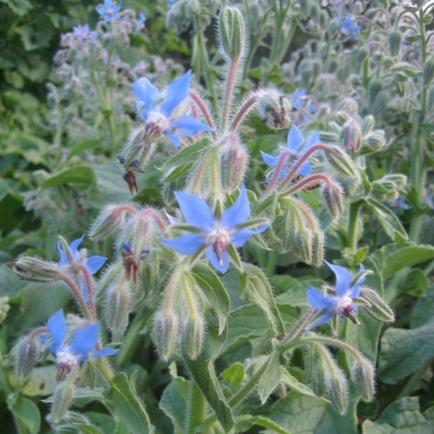
Plant Personality: Borage, a friend to gardens and gardeners
Borage Art Pack - the original artwork is an embroidery Donna Sharrett, the artist behind the Borage Art Pack and a gardener in Westchester County sent us her thoughts on Borage. This beautiful plant is often cornered into one category: beauty, medicine, or food, but really it's all three and much more:
Borago officinalis, a versatile garden charmer is attractive, easy to grow and a bountiful source of nectar for bees. Gardeners and orchard growers alike plant Borage to entice these hard working pollinators. Bees love Borage and gardens love bees! Beyond bees Borage bestows other bonuses. This herb produces edible flowers and leaves. The leaves, despite being covered in a soft fuzz, are popular in German and Spanish soups and sauces. Fresh flowers adorn salads (and taste like cucumbers!) while candied blooms are used to garnish confections. As a companion plant it is thought to improve disease resistance & flavor of neighboring tomato, squash and strawberry plants. Borage seeds are rich in gamma linolenic acid, a medicinally valued essential fatty acid and as such, the plant is a commercial crop in Canada, Chile, The Netherlands, New Zealand, the United Kingdom and here in the US. The specific epithet officinalis is Latin for medicinal.
Borage is a member of the Boraginaceae Family which is often referred to as the Forget-me-not Family. Family members native to New York are Hackelia virginiana (L.) Johnst., commonly known as Stickseed; Myosotis laxa Lehm., commonly known as Wild Forget-me-not; Myosotis verna Nutt., commonly known as Spring Forget-me-not and Onosmodium virginianum (L.) A.DC., commonly known as False Gromwell.
Growing Borage: Borage is an introduced, tap-rooted annual preferring well-drained fertile soil, full sun and protection from the wind. Not easily transplanted, seeds should be directly sown in early spring. Known as Starflower in the UK and elsewhere, it grows to a height of up to 24 inches with racemes of circinate 5-petaled star shaped blue flowers borne on bristly stems that appear silvery in sunlight. This prolific season long bloomer self seeds, returning year after year while yielding an abundance of seeds.
Donna Sharrett, Master Gardener Volunteer - Westchester Cornell Cooperative Extension







